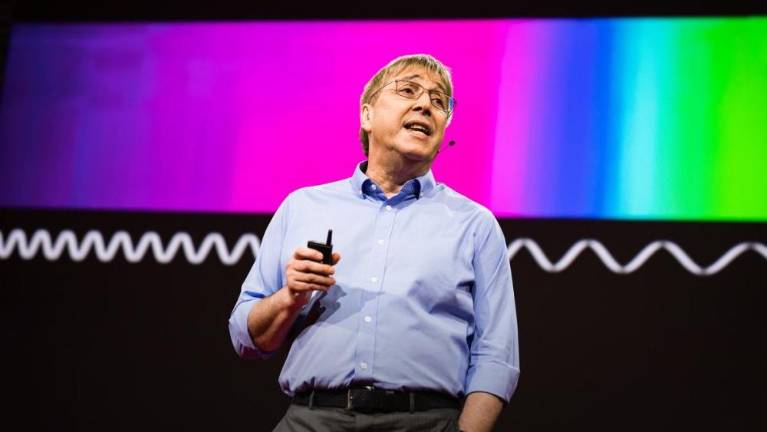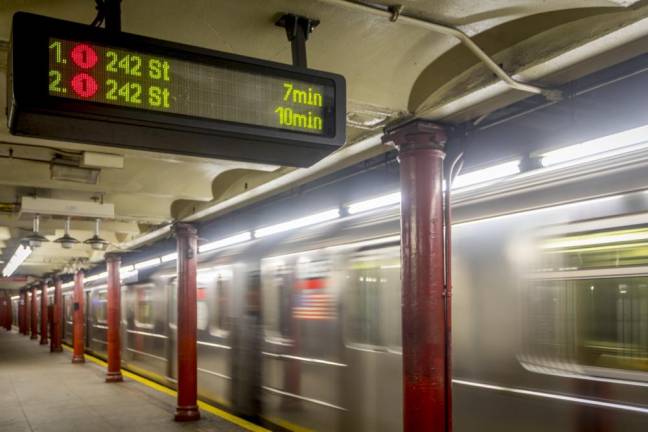A 'Far Light' Solution?
Scientists at Columbia say a safer form of ultraviolet light could disrupt airborne coronavirus transmission


EXCLUSIVE - In a sealed lab at Columbia University, researchers say they have found a way to destroy coronavirus in the air and thus make it safer to resume using public spaces like subways, theaters, stores, offices, airports, restaurants and even bars.
If the scientists have it right, their invention would address one of the most daunting challenges to reopening businesses that depend on crowds of people or to workers getting to their jobs. Even with hand washing and social distancing, the virus is transmitted in at least a portion of cases by floating in the air until someone breathes it in, scientists report.
The urgency of this was underlined on Friday, May 1 in an article from a separate group of researchers. “The currently available evidence strongly suggests the immediate need to address the significance of Sars-CoV-2 aerosol transmission,” the researchers wrote in an overview for the journal Risk Analysis.
Aerosol transmission, in which a pathogen hitches to a globule of water so tiny it can ride the air, is at the heart of the work of David J. Brenner at Columbia for the past six years, long before Sars-CoV-2, the virus that causes COVID-19, emerged in Wuhan, China.
In 2018 Brenner and colleagues published a peer reviewed article reporting that they could destroy airborne flu virus, prompting a spate of news stories asking if this was a path to more moderate flu seasons. Having now demonstrated their system on coronaviruses similar to the type that causes COVID-19, Brenner, who is Higgins Professor of Radiation Biophysics at Columbia University Irving Medical Center in Washington Heights, says the next step is to deploy this to retard the pandemic.
“We certainly see this approach as a potential game-changer as people start to get back to work, and we are inevitably going to be closer to each other, in trains, in planes, in offices, in restaurants, in grocery stores, etc. etc,” Brenner wrote in an email on April 30. “Given this situation, we need some easy-to-use approaches for continuous disinfection of the air in occupied public places, to reduce the risk of person-to person viral transmission.”
Safety Concern
Brenner’s invention is a modernization of the ultraviolet light techniques that have been in use for 100 years to disinfect hospitals and other facilities.
UV light is well established for its ability to destroy both bacteria, like those that cause TB, and viruses, including coronaviruses and influenza. Its use has been restricted, however, because the most commonly used forms of UV light also burn skin and damage eyes.
Indeed, David Sliney, the chair of the task force on Germicidal Ultra Violet Light and Covid-19 created by the Illuminating Engineering Society, says UV light was far more widely used for disinfection until the 1960s, when concern about eye and skin damage of those exposed to it overwhelmed concerns about infection.
Brenner says that his version of UV light, called Far UVC, alleviates the safety concern. The key is that Brenner uses shorter wavelength UV, which can still destroy bacteria and viruses but can’t penetrate the top layers of skin or even the watery covering of the eyes. “It cannot reach living human cells in the skin or eyes,” Brenner and three colleagues wrote in the journal NatureResearch, last week. “But because viruses (and bacteria) are extremely small, far-UVC light can still penetrate and kill them. Thus far-UVC light has about the same highly effective germicidal properties of UV light, but without the associated human health risks.”
That paper described the success of Far UVC Light in destroying two coronaviruses that cause the common cold. “The researchers are now testing the light against the SARS-CoV-2 virus in collaboration with Thomas Briese and W. Ian Lipkin of the Center for Infection and Immunity in a biosafety laboratory on Columbia's medical center campus, with encouraging results,” according to an annoucnment from the university two weeks ago.
UV Light Fixture
The pandemic has sparked a renewed interest in UV light, in general, as a tool to make shared spaces safer. Brenner is working with the New York City Transit Authority on a test of traditional UV light for disinfecting subway cars.
"MTA's (logical) plan is to start with conventional germicidal UV, then potentially move to far-UVC, which can be used in occupied trains and buses, when the far-UVC lamps are available and all the approvals are in place," Brenner said by email on Monday.
Two Korean companies announced the other day that they had created a UV light fixture to disinfect the interior of a car. That could be a big help in expanding confidence in cabs and ride-hailing services. The only catch is the car interior has to be empty, for about ten minutes, because the UV light is of the higher bandwidth.
At Cedar-Sinai Medical Center in Los Angeles, researchers have been looking at a technique for inserting a UV light source down an intubation tube to kill coronavirus inside infected patients. This may have been the research President Trump had in mind when he talked at a recent press conference about inserting light into the body. The Medical Center says the technique has not yet been tried on any patients.
The task force chaired by Sliney, who served as a radiation expert in the Army Medical Corps, reported last month that Germicidal UV light could be used more to control coronavirus. “More-widespread use of GUV is often limited by safety concerns, but these are manageable and minor compared to potential infection prevention,” the task force reported last month (April 15). “Most of the public are not aware of its unique value in disinfection of air and contaminated surfaces.”
The biggest risk with Germicidal UV is improper placement of the lights, something that can be addressed with training and labeling, Sliney said.
One UV technique that Sliney says could be expanded, is to shine UV light even of the higher wavelength type across the upper portions of large rooms and other public spaces above the heads of people. This technique takes advantage of the circulation of the air. As the air from below rises (remember people are warm and warm air rises) into the upper portions of the space it is disinfected.
Pointing the UV up in this way is an effective disinfectant, Sliney said by phone from his home in Florida, although not as effective as pointing it down would be. In essence, Brenner says he has invented a UV light that can be pointed down safely.
A couple of years ago, Sliney tried to convince his son, who owns a restaurant, to install an upper air UV system. It would have cost about $1000, Sliney said. In the end, his son didn’t bother and Sliney said he now wishes he had pushed harder. He worried that the lights and fixtures would now be in such demand that they would be far more expensive or unattainable.
With all the focus on speedier production of personal protective equipment, it isn’t clear who has even been looking at the question of production of UV lights. Most of the firms in the United States in this business are small “mom and pop” companies, Sliney said, because larger firms had withdrawn as the market shrank
When asked how soon Far UVC light could be deployed, Brenner said: “That really depends on how fast the manufacturers can ramp up production into the hundreds of thousands. By the autumn they are telling us.”
“We certainly see this approach as a potential game-changer as people start to get back to work, and we are inevitably going to be closer to each other, in trains, in planes, in offices, in restaurants, in grocery stores, etc.” David J. Brenner, Columbia Medical Center